Bold, salty, and earthy, beet kvass is a thousand-year-old traditional fermented beverage renowned as a health tonic! Here’s how to make it and flavor it so it actually tastes good!
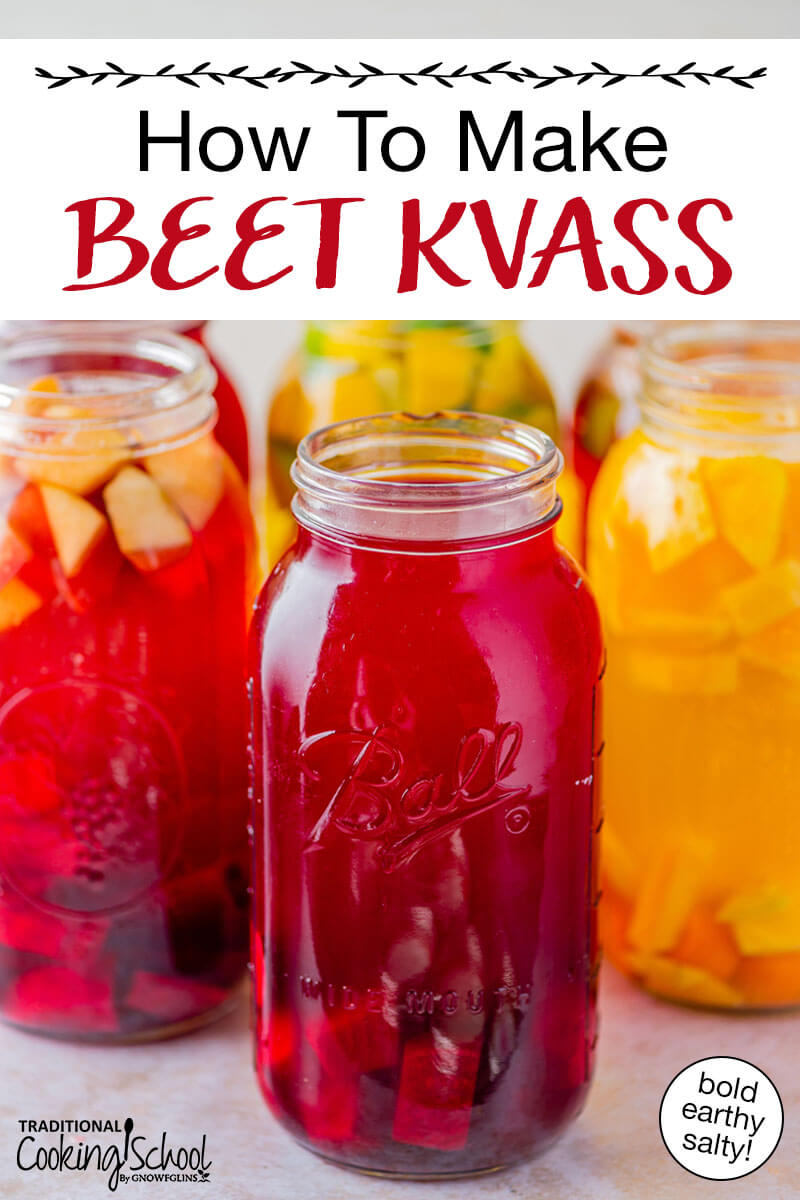
Table Of Contents
What Is Beet Kvass?
Kvass is a traditional beverage from eastern Europe made by fermenting (usually rye) bread. People would make it from berries or other foods as well — and in the Ukraine, every household would make it from beets.
In kvass, beneficial bacteria called Lactobacilli consume the beet sugars, producing beneficial lactic acid, increasing vitamins and enzymes, and multiplying throughout the beverage to make it extremely probiotic.
The end result is a rich, salty, earthy superfood.
And, you can make at least two batches of beet kvass out of the same beets. It’s very frugal! 🙂
Health Benefits of Beet Kvass
According to Nourishing Traditions, beet kvass is an “excellent blood tonic, promotes regularity, aids digestion, alkalizes the blood, cleanses the liver and is a good treatment for kidney stones and other ailments.”
I can vouch for some of those health benefits being practically instantaneous! So my husband and I take a little shot of it every morning. Just a few ounces a day is all that’s needed.
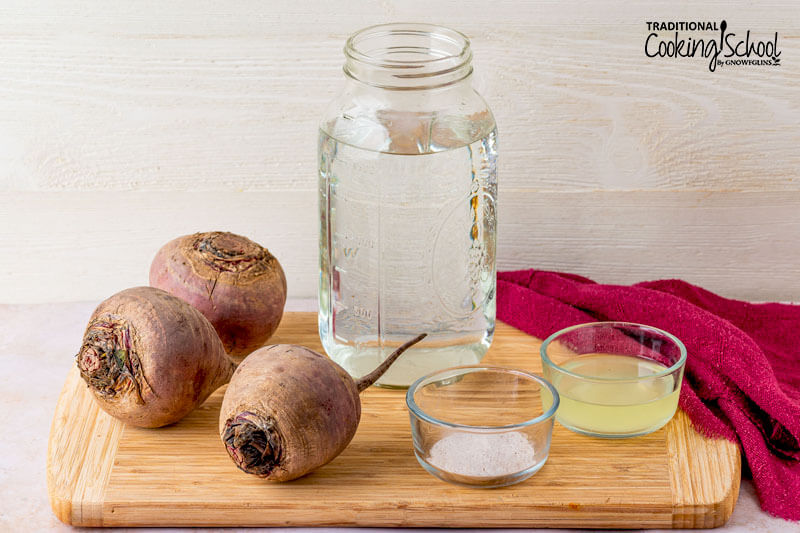
Ingredients
- Beets – Organic and/or local, if possible.
- Sea salt – Choose a high-quality, fine-grain, mineral-rich salt. Don’t use store-bought, commercial iodized salt. Salt is not optional since it protects the fermenting foods from putrefying bacteria while allowing the beneficial bacteria necessary for proper fermentation to thrive. It’s essential, in the amount written below, for safe fermentation.
- Starter culture – Use whey (learn how to make it here!), finished kvass from a previous batch, or another fermenting liquid such as sauerkraut or pickle juice. Other dairy-free substitutes for whey can be found here. You could also double the salt and omit the starter culture, but I find that makes too salty a beverage.
- Pure water – Use mineral-rich, chlorine-free water rather than contaminated well water or straight city water which may contain chlorine, chloramine, and/or flouride, etc. Mixing chlorinated water with cultures can affect your lacto-fermentation recipes. If your water is not clean or you don’t filter it, I recommend purchasing spring water or filtered water (here’s how to choose the best water filter for your family!). If your water is filtered and does not re-add minerals back, consider fortifying it with natural mineral drops. I discuss using reverse osmosis water for fermenting in this #AskWardee.
Equipment/Supplies Needed
No fancy equipment required!
- Glass jars – You will need a half-gallon glass jar, preferably wide mouth, for fermenting the kvass, and a quart-sized glass jar for storing the finished kvass after fermentation.
- Metal bands and lids – For covering the jars of fermenting and finished beet kvass.
Directions
For a video demonstration of this recipe, be sure to check out my Lacto-Fermentation eCourse.
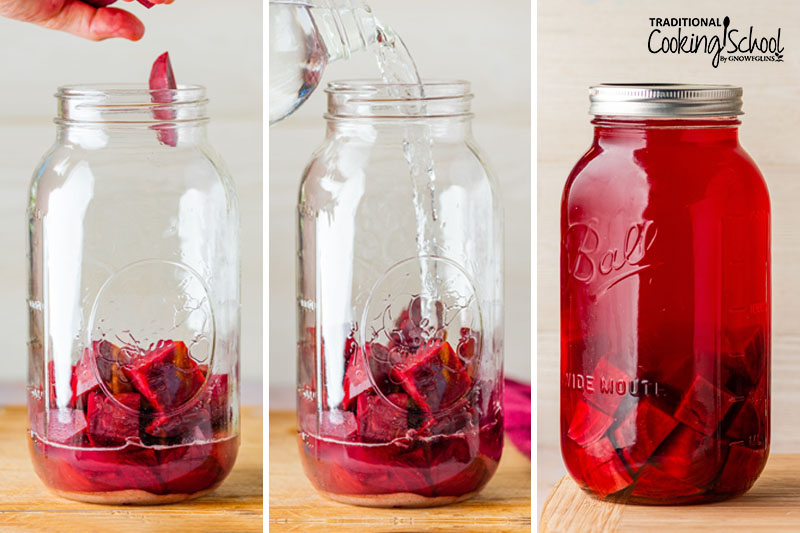
1. Combine peeled and chopped beets, salt and whey in a half-gallon jar.
2. Add water to fill, leaving 1-inch space at the top. Cover tightly with lid or airlock.
3. Leave at room temperature for two to three days.
4. Leaving the solid ingredients behind, pour all but about 10 percent (does not have to be exact) of the liquid into a wide-mouth quart jar.
5. Cover quart jar and transfer to refrigerator. This is the first batch.
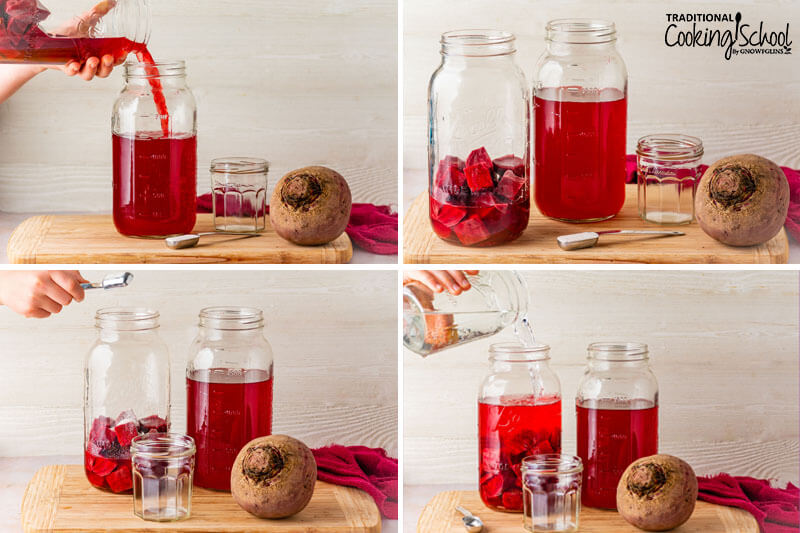
6. To make a second batch, add additional salt to the half-gallon container that contains the other ingredients.
7. Add water to fill, leaving a 1-inch space at the top. Cover tightly with lid or airlock.
8. Leave at room temperature for two to three days.
9. Pour all the liquid into a wide-mouth quart jar. Cover jar and transfer to the refrigerator. This is the second batch, and it will probably be weaker than the first.
10. You can repeat the process again to make a third batch (much weaker), or you can discard or compost the solid ingredients and start over with new ingredients.
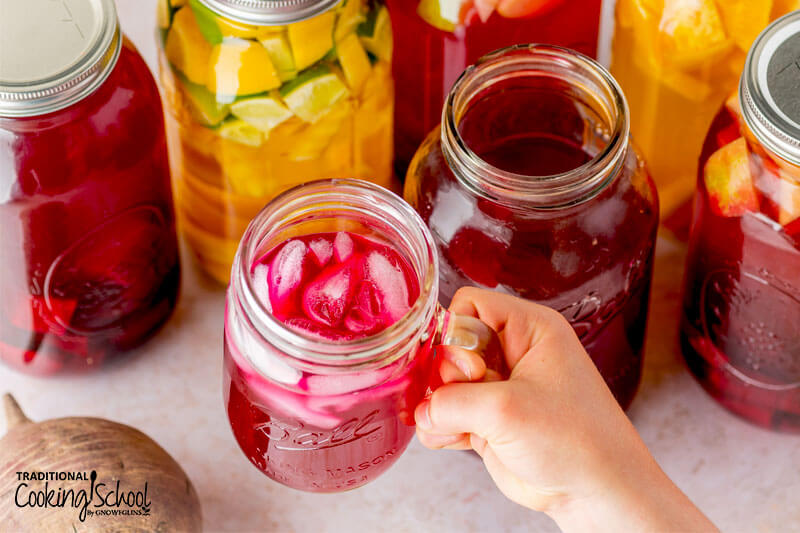
How to Drink Kvass
With any ferment, it’s important to start slow and work your way up to larger amounts if you’re not used to consuming probiotic-rich foods. Start with a few teaspoons a day of beet kvass, drunk in the morning with breakfast, and gradually build up to an ounce or two a day.
It’s a delicious accompaniment to your busy days — the perfect way to hydrate and refresh in the morning!
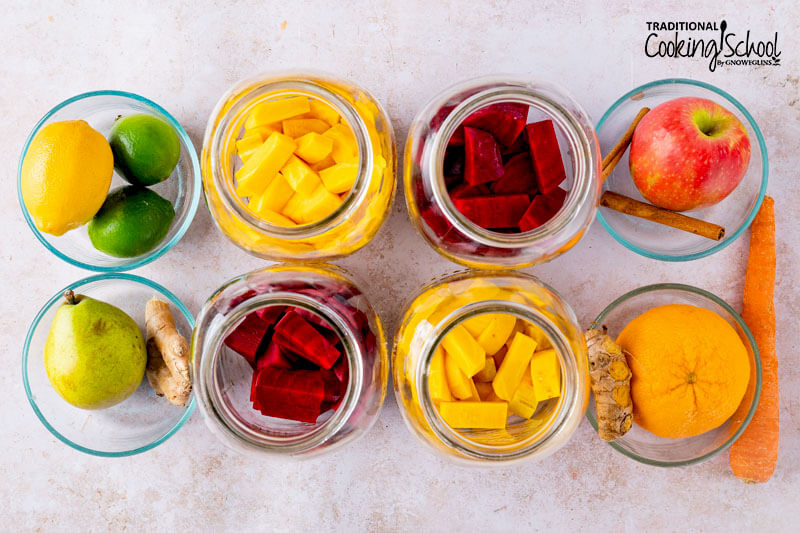
Kvass Flavor Options
For some, beet kvass is an acquired taste. It is bold, earthy, salty, rich… not sweet, fruity, or mild! If that’s a hard sell for you or any family members, consider adding fruit or spices to make it more palatable. Any of the options below would be delicious!
- Apples
- Pears
- Oranges or other citrus fruits
- Carrots
- Strawberries
- Raspberries
- Ginger
- Cinnamon
You can also sweeten your kvass to taste with maple syrup or honey after fermentation.
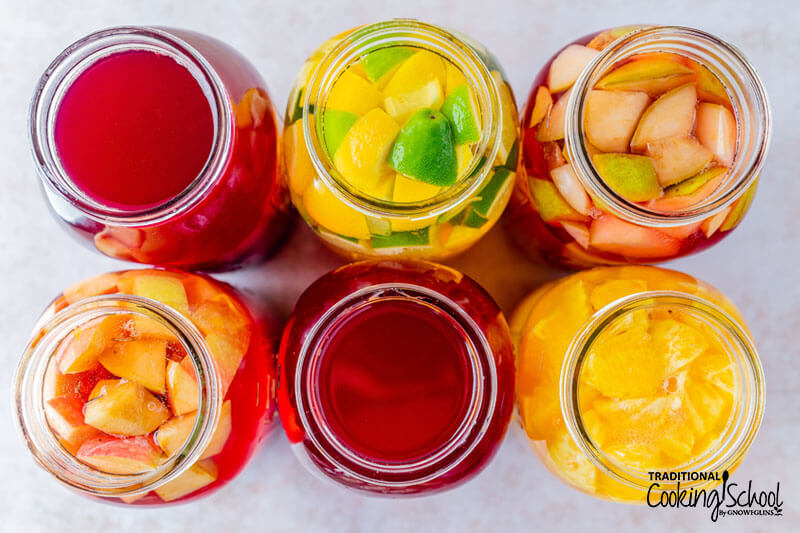
Frequently Asked Questions & Troubleshooting Tips
There’s a film on my beet kvass?
A film is harmless, as long as it’s white and thin (not thick and fuzzy like mold… here’s what to do if your ferment is moldy). This is a yeast overgrowth called kahm yeast that occurs at the top of the ferment where it is exposed to oxygen. Though we all prefer to skim it away, it is not harmful if ingested.
Kahm yeast can leave an off-flavor in your kvass, though, so skim it away and move the kvass to cold storage so it doesn’t grow back.
I share tips for how to reduce the likelihood of this happening again, including what to do if it does happen, in this #AskWardee.
Keeping your ferment warm enough.
Most fermentation happens best around room temperature, or 72 degrees Fahrenheit. If your house is on the cool side, here’s what you can do to keep your ferment happy and the beneficial bacteria thriving:
- Insulate your ferment by wrapping it in towels.
- Keep your ferment on a seedling warming mat.
- Keep your ferment on top of a warm appliance, such as the fridge.
This #AskWardee has even more ideas for you!
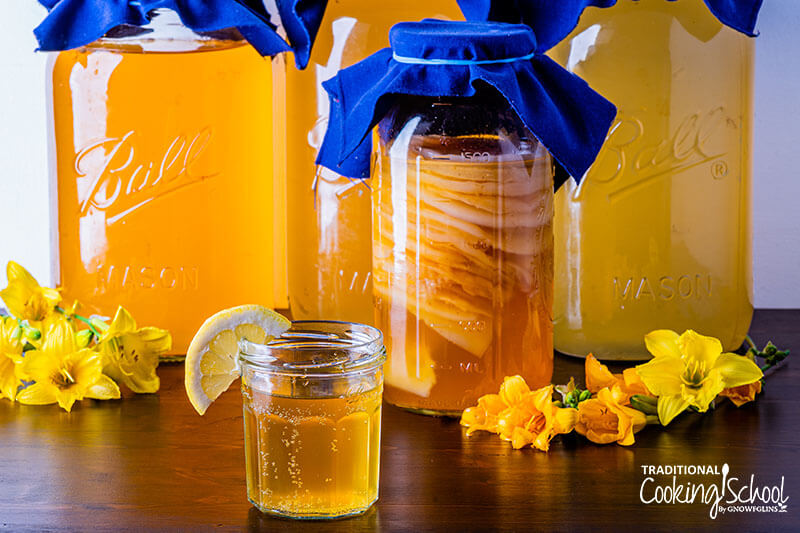
Other Fermented Beverages
- How To Make Kombucha (pictured above)
- The ULTIMATE Kombucha Guide
- The ULTIMATE Water Kefir Guide
- 50+ Probiotic & Fermented Drinks Beyond Kombucha & Kefir!
- Is Jun Right For You? All Your Questions Answered!
- Honey-Sweetened Ginger Beer {probiotic, non-alcoholic, GAPS-friendly natural soda!}
- Spontaneously Fermented Sparkling Apple Cider
- 5-Minute Probiotic Mixed Berry Switchel {Paleo, GAPS, AIP}
- Fermenting Trouble Shooting FAQ’s
Did you make this beet kvass recipe? If so, please give us a rating on the recipe card below. Then snap a photo and tag us on social media so we can see how you chose to flavor it!
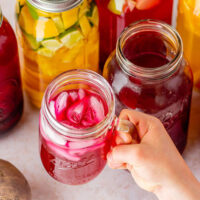
Beet Kvass
Adapted from the recipe in Nourishing Traditions. For a video demonstration of this recipe, be sure to check out my Lacto-Fermentation eCourse. This recipe yields 1 quart of beet kvass per batch, so 2 quarts total.
Ingredients
- 3 medium beets about 3" to 4" diameter, peeled and chopped into 3/4" to 1" wide pieces (not shredded)
- 1-1/2 tablespoons sea salt first batch, plus scant 1 tablespoon (second batch)
- 1/4 cup whey *
- pure water
Instructions
-
Add peeled and chopped beets.
-
Add water to fill to within 1 inch of the top of the container.
-
Cover tightly.
-
Let ferment at room temperature for 2 to 3 days.
-
Leaving the beets behind, pour all but about 10% of the finished kvass into a glass jar and transfer to the refrigerator. That is what you'll drink, a few ounces at a time, daily or twice daily. The remaining 10% of kvass is the "starter" to get your next batch going.
-
To make your second batch, add additional salt to the remaining kvass and beets in your fermenting vessel.
-
Fill with water to within 1 inch of the top of the container.
-
Cover tightly.
-
Let ferment at room temperature for 2 to 3 days.
-
Now, pour all the finished kvass into a glass jar, transfer to the fridge, and send the beets off to the compost... or make a third (very weak) batch of kvass.
-
If you'd like start a 3rd batch, do it exactly as you did the 2nd.
Recipe Notes
*Here's how to make whey, including dairy-free substitutes.
This post was featured in 56 Fermented Probiotic Drinks {beyond kombucha & kefir!}.
This post was originally published and written by Wardee Harmon on 8/12/11. It was updated and republished on 6/30/21.
...without giving up the foods you love or spending all day in the kitchen!

2 free books:
Eat God's Way
Ditch the Standard American Diet, get healthier & happier, and save money on groceries...
We only recommend products and services we wholeheartedly endorse. This post may contain special links through which we earn a small commission if you make a purchase (though your price is the same).


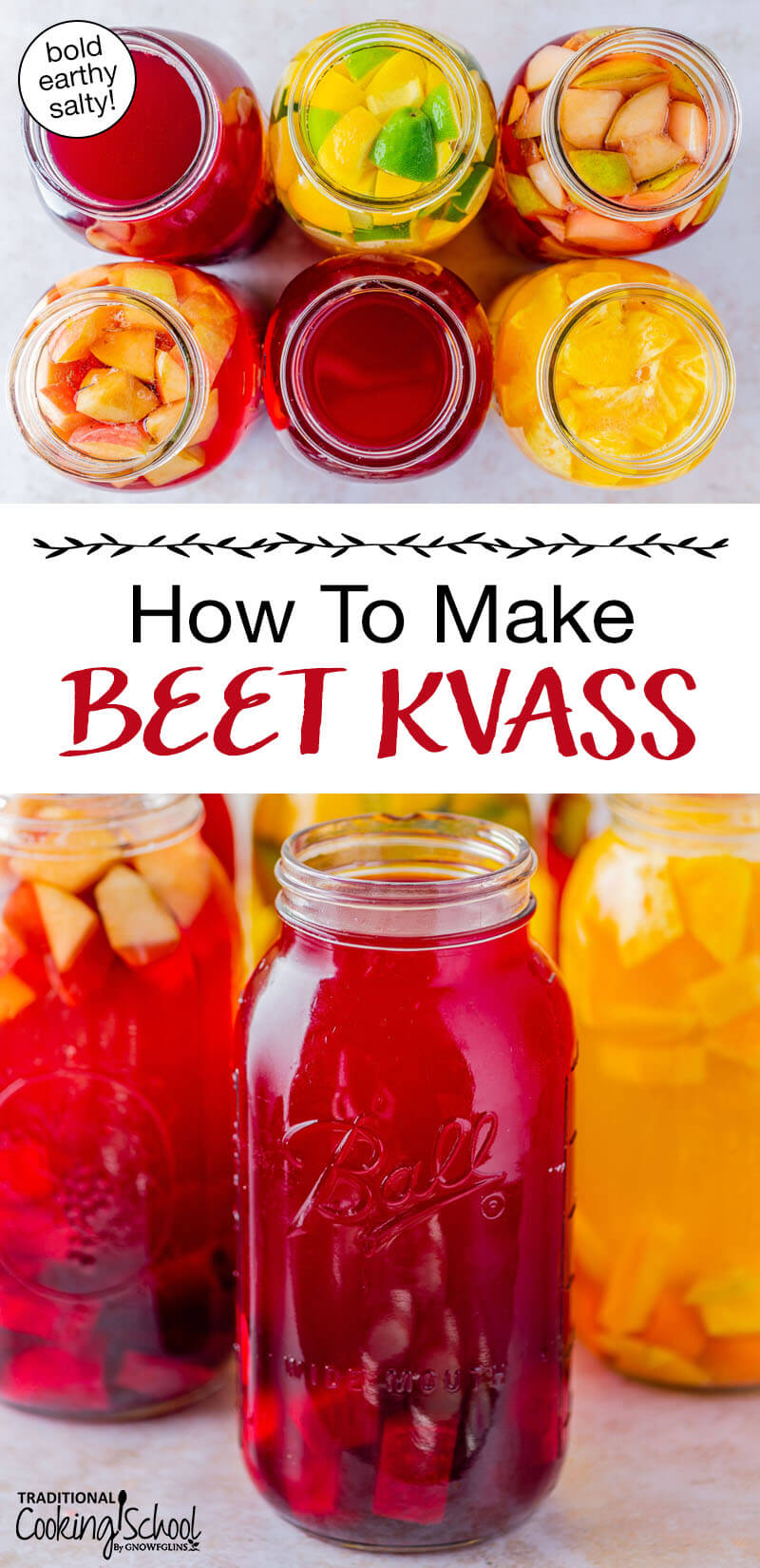
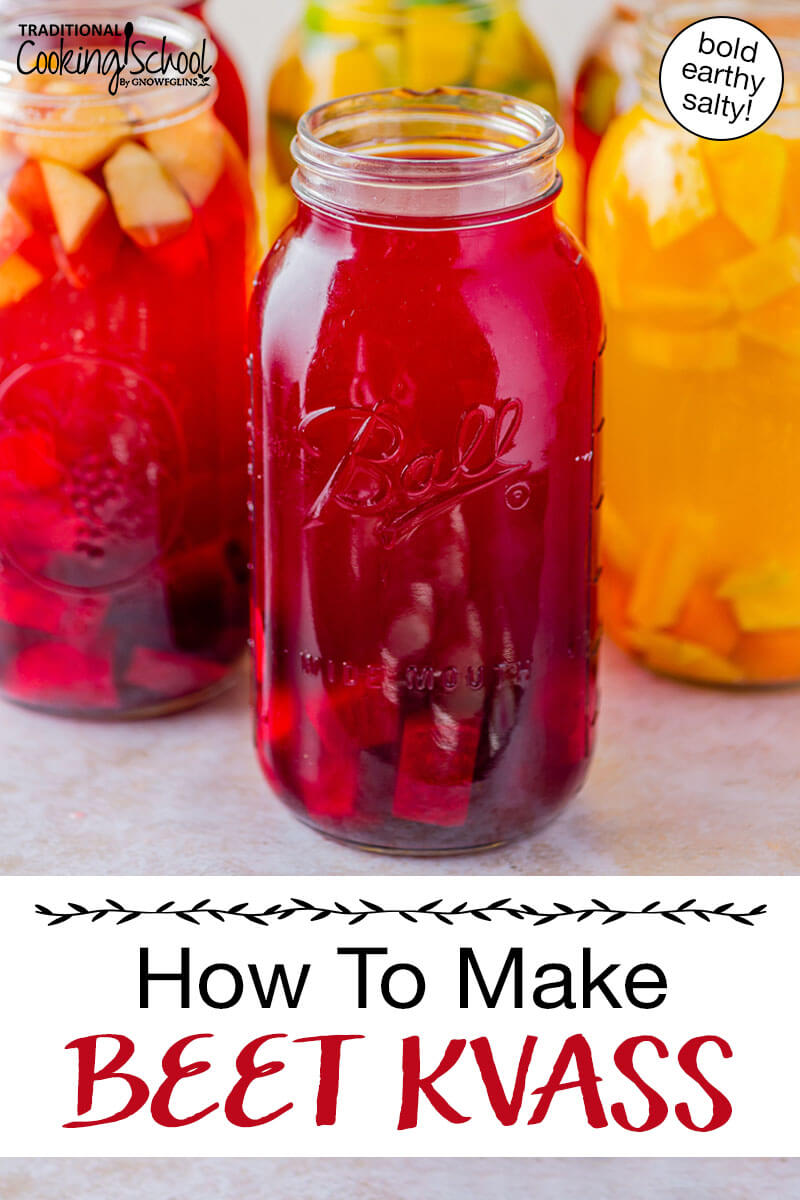
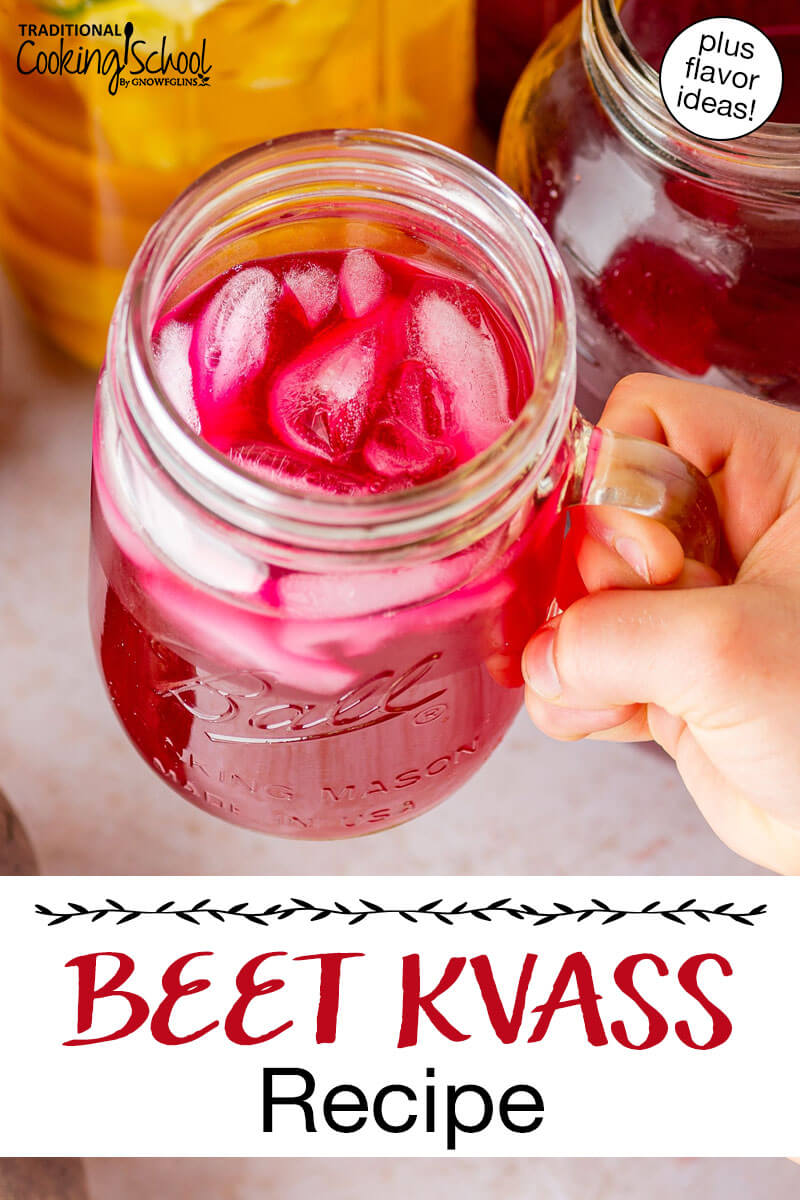
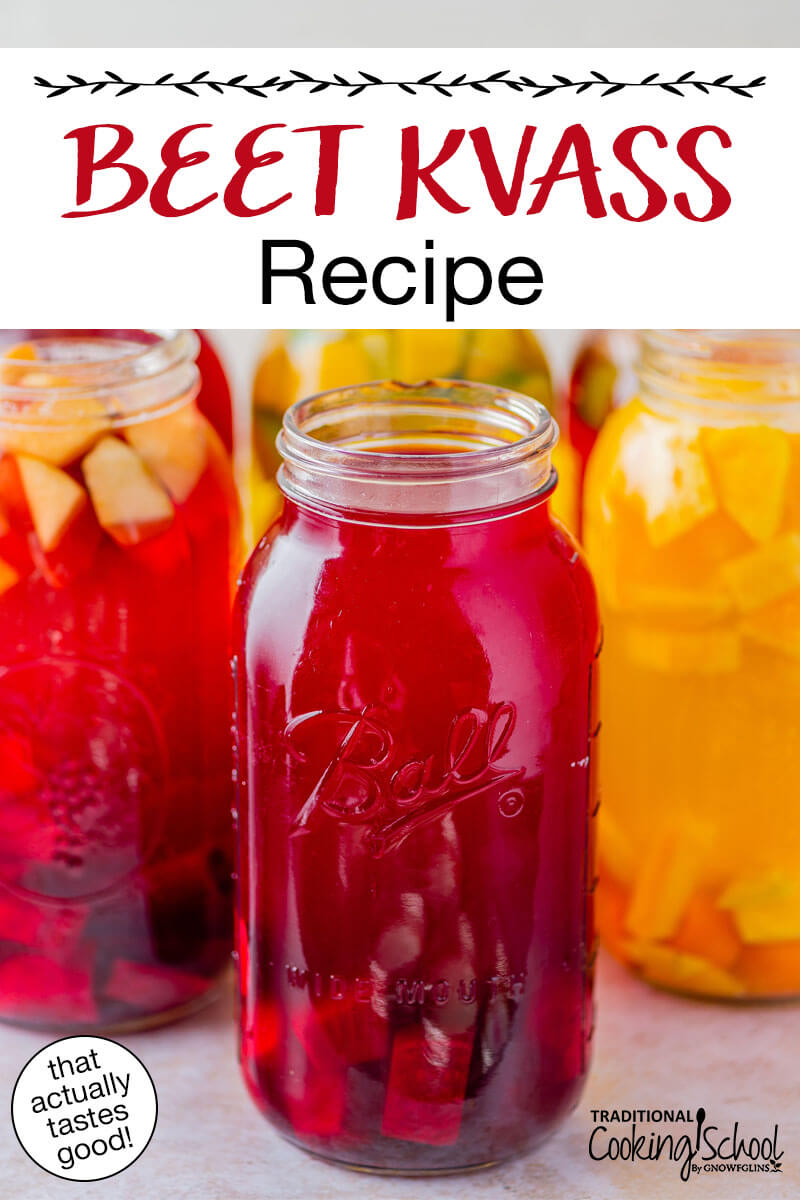
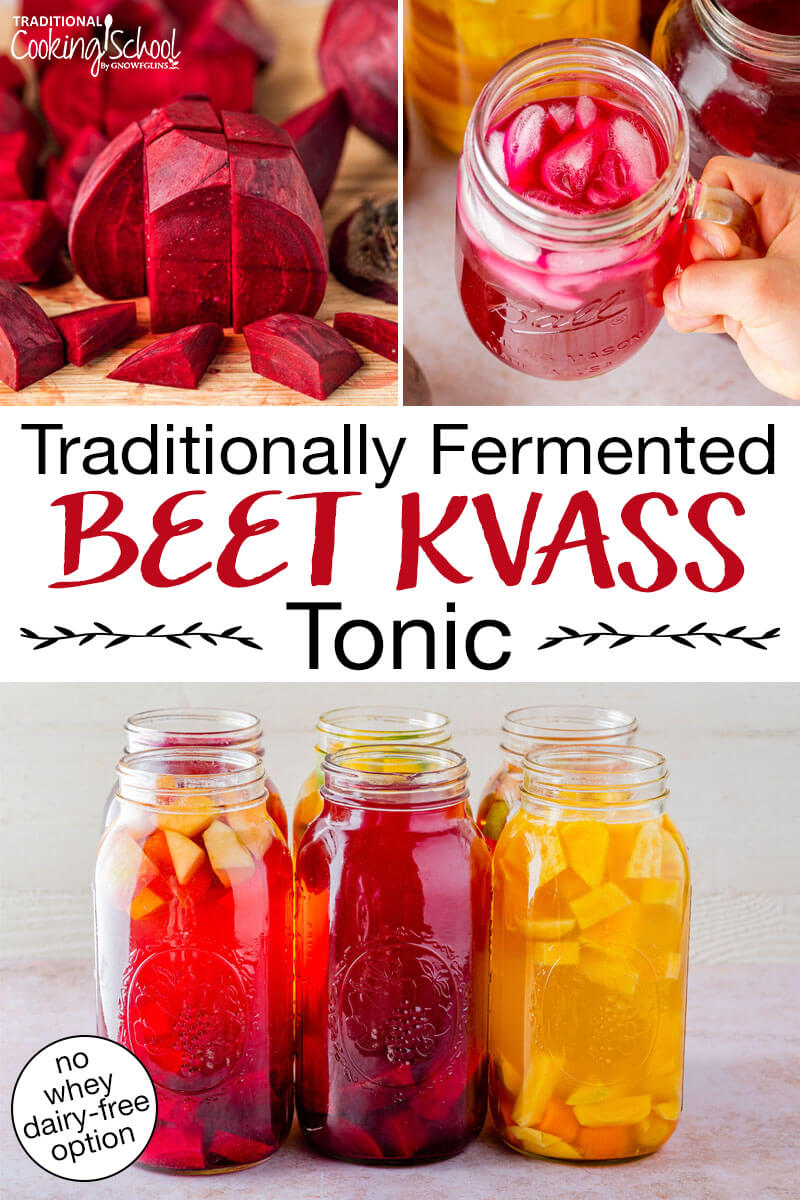
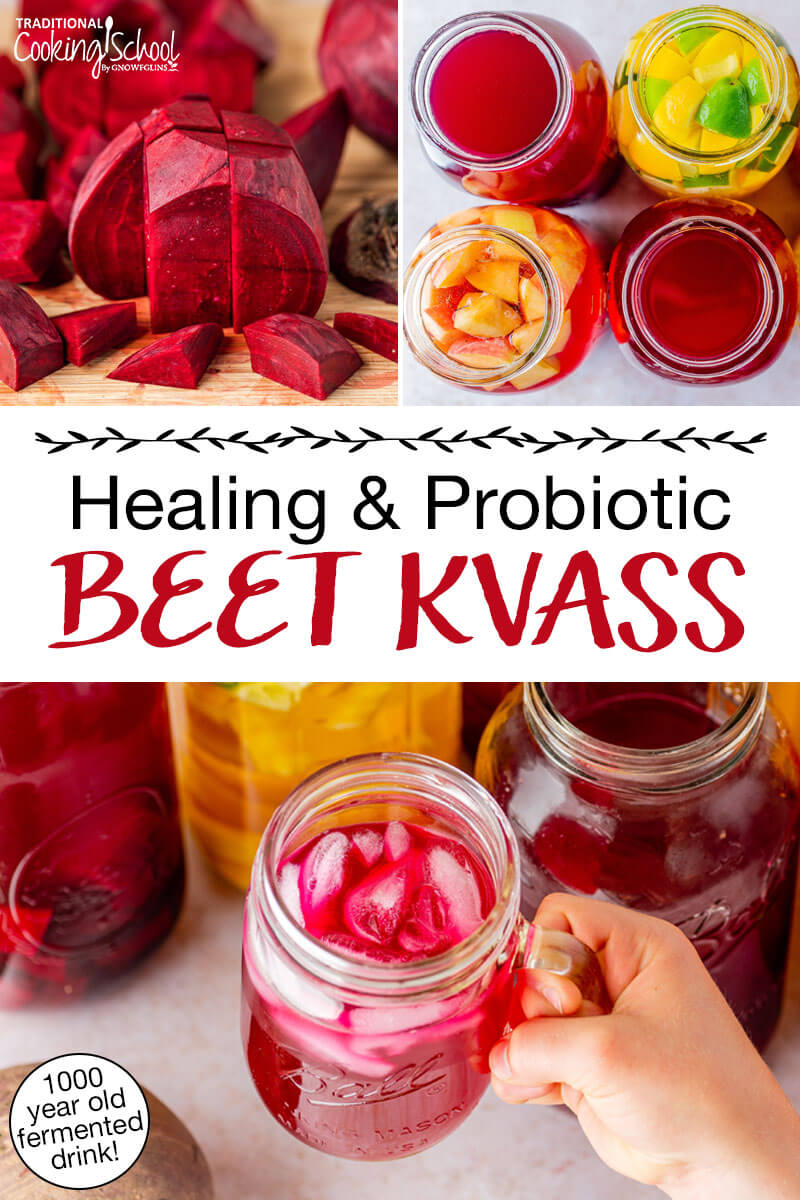
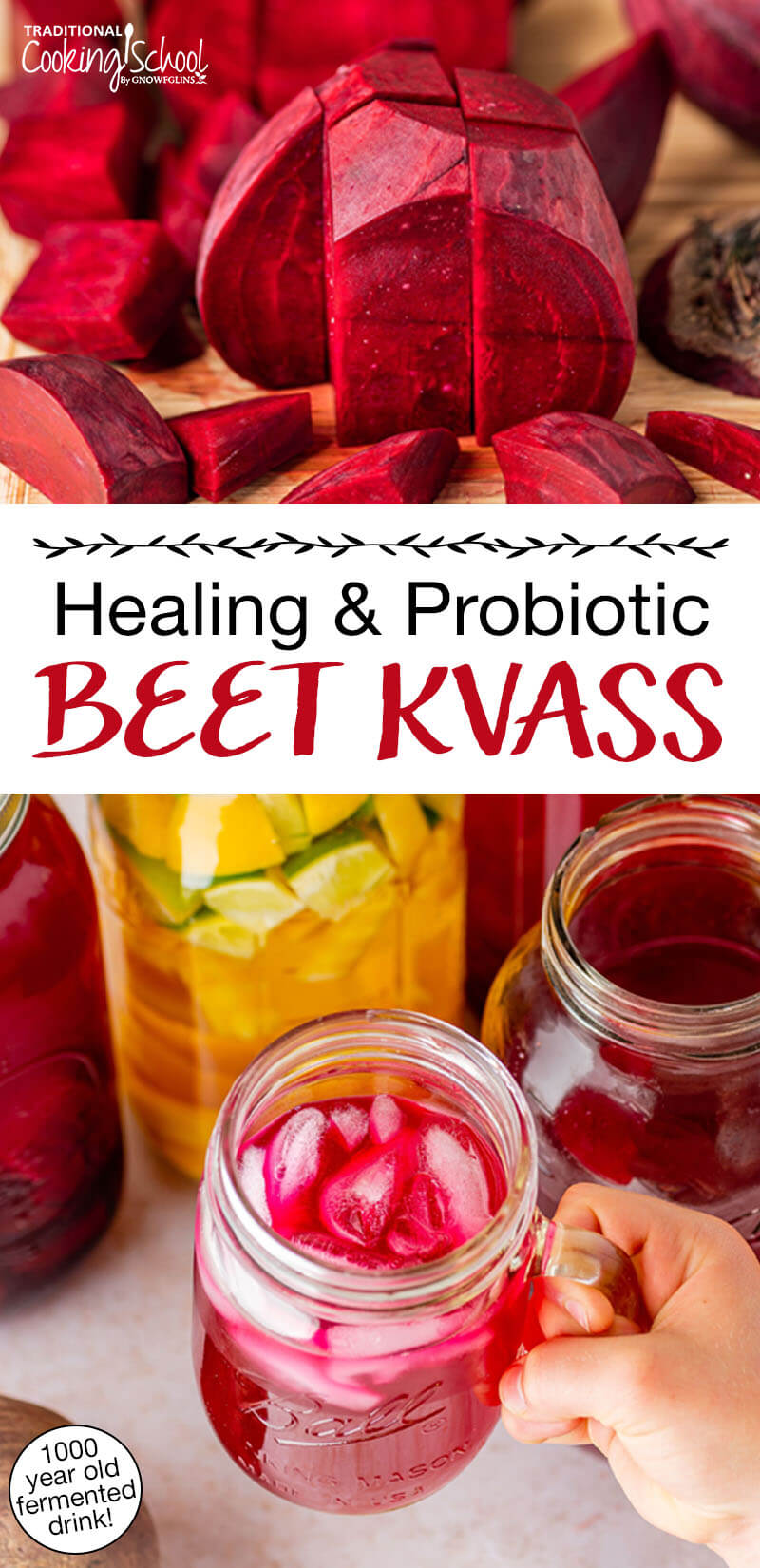
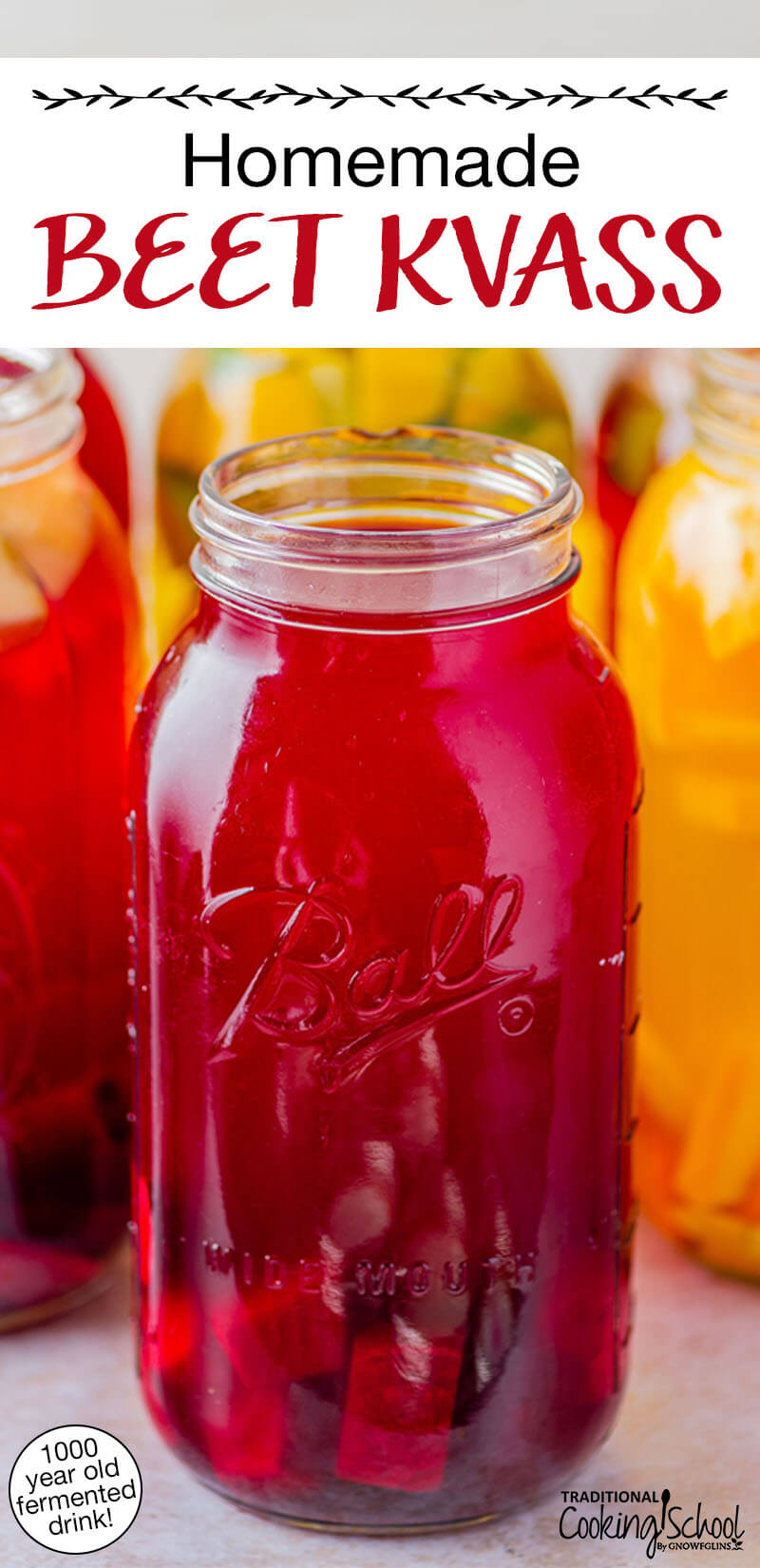
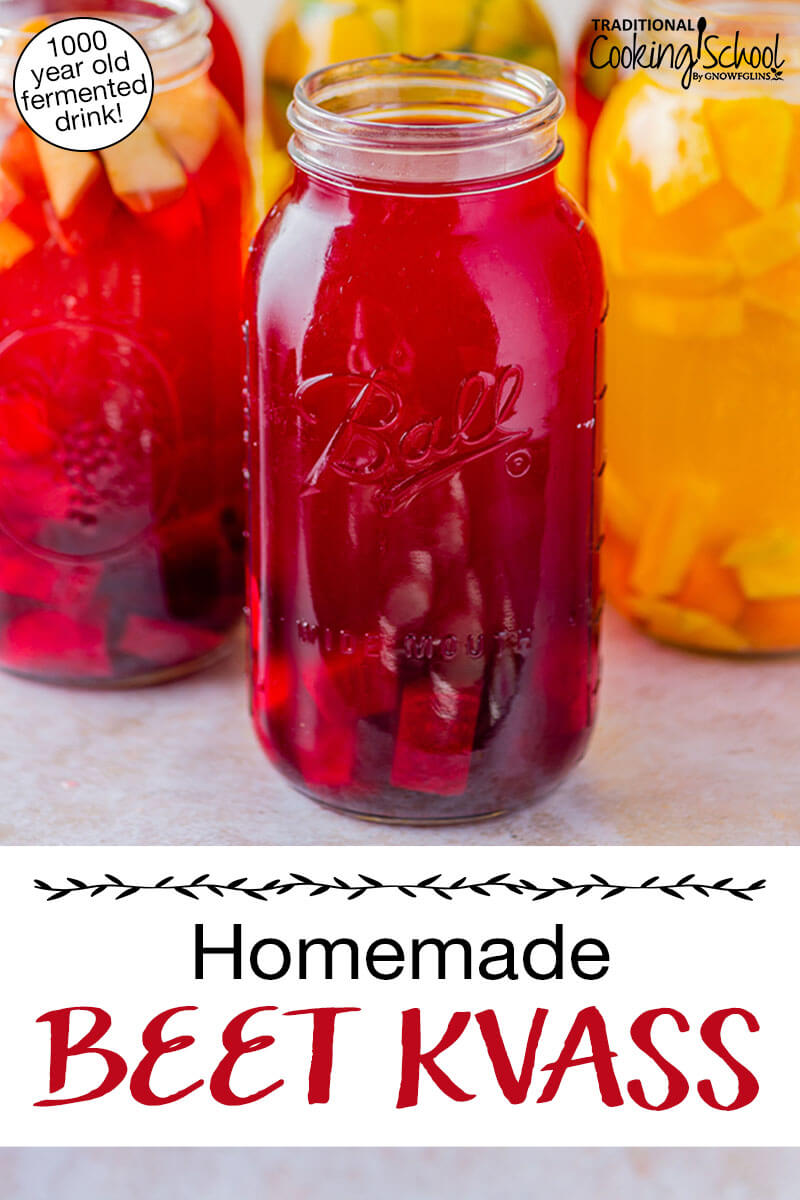
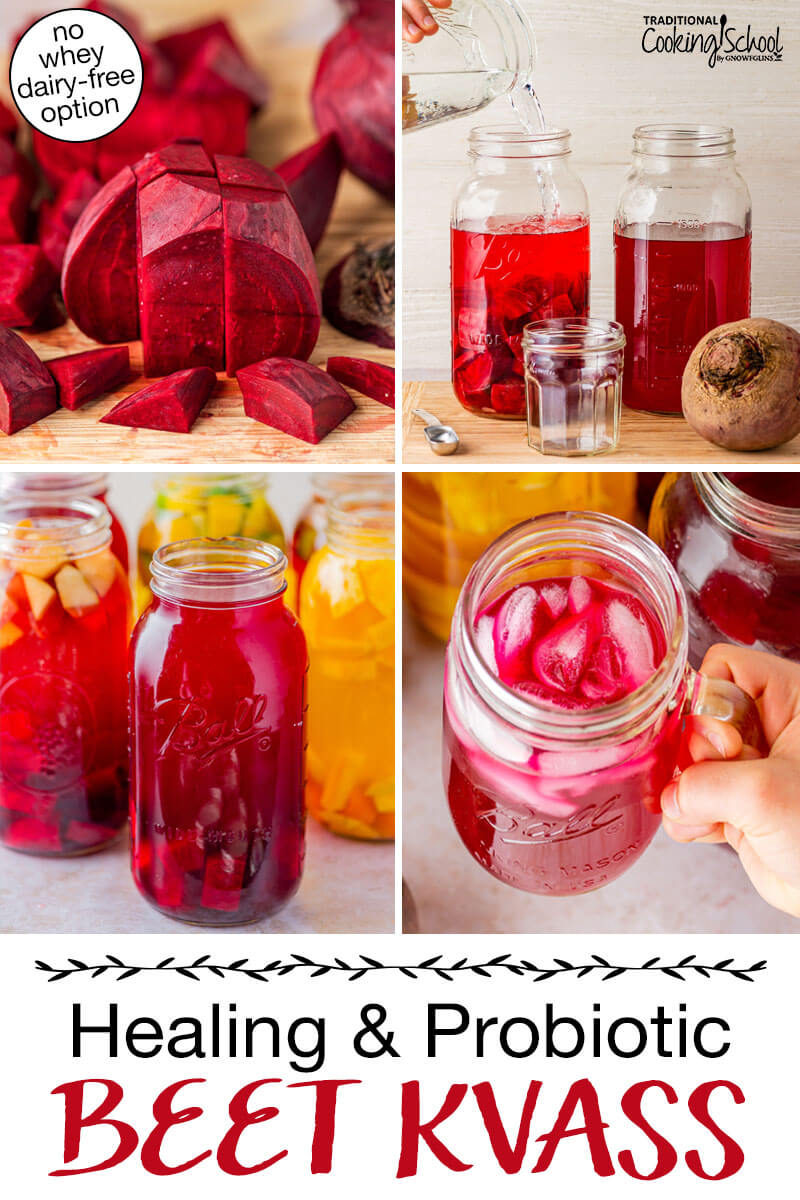
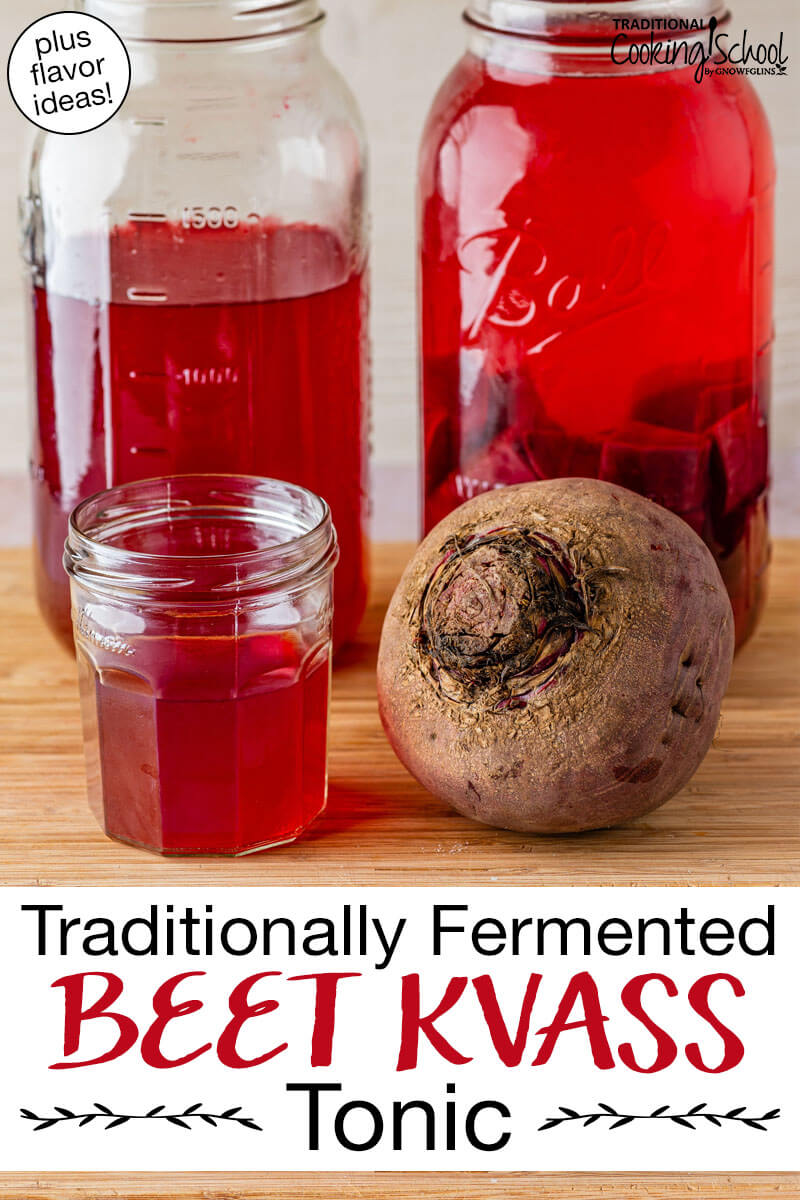
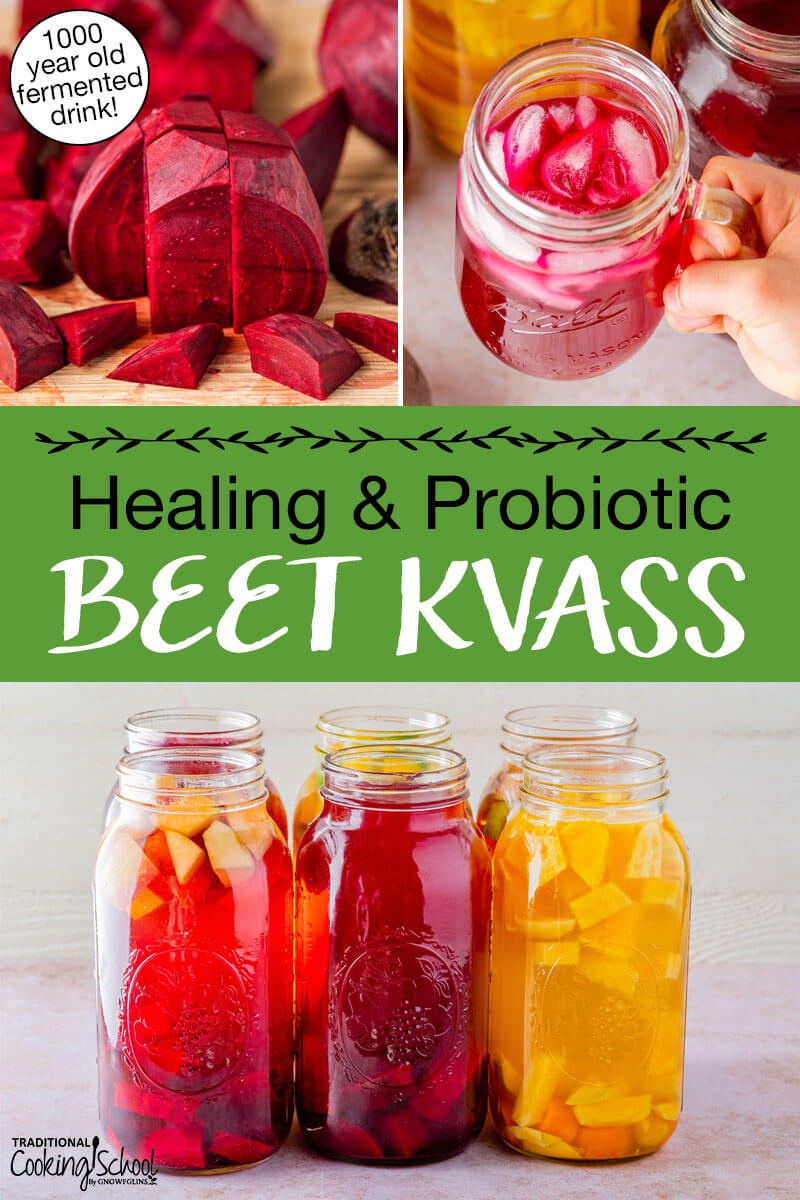
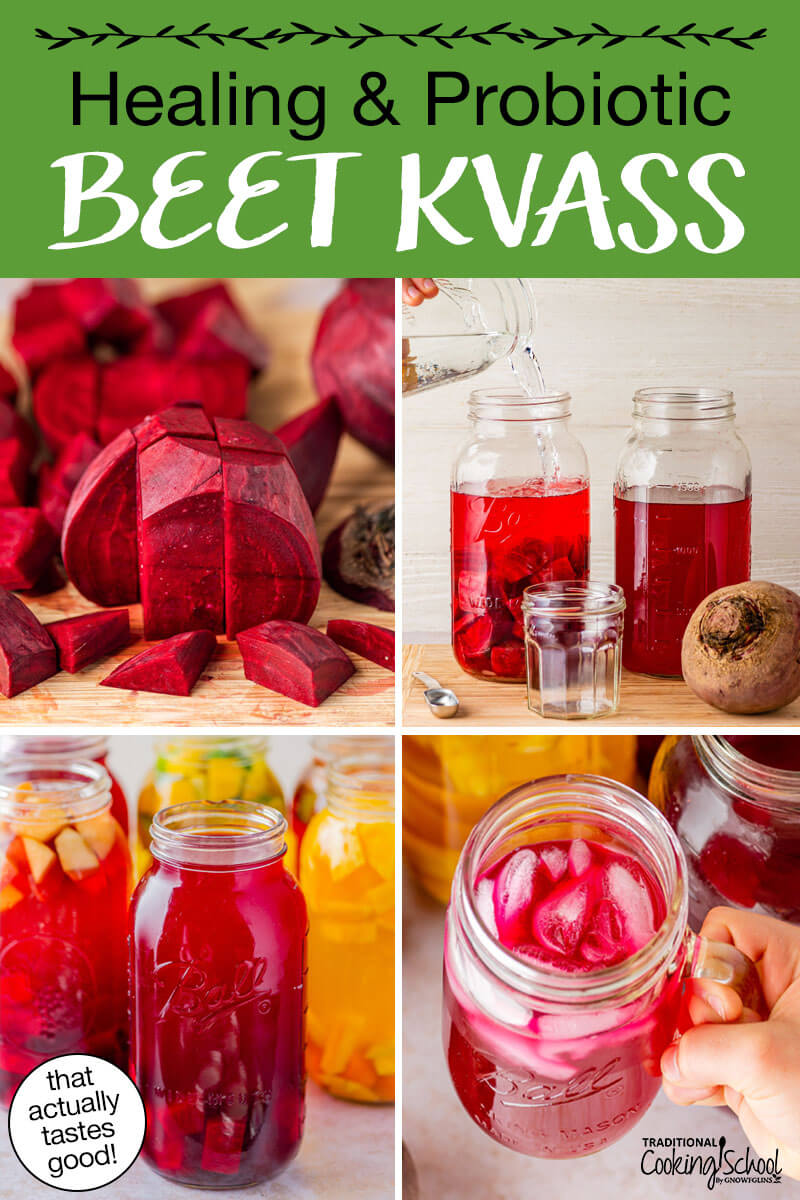
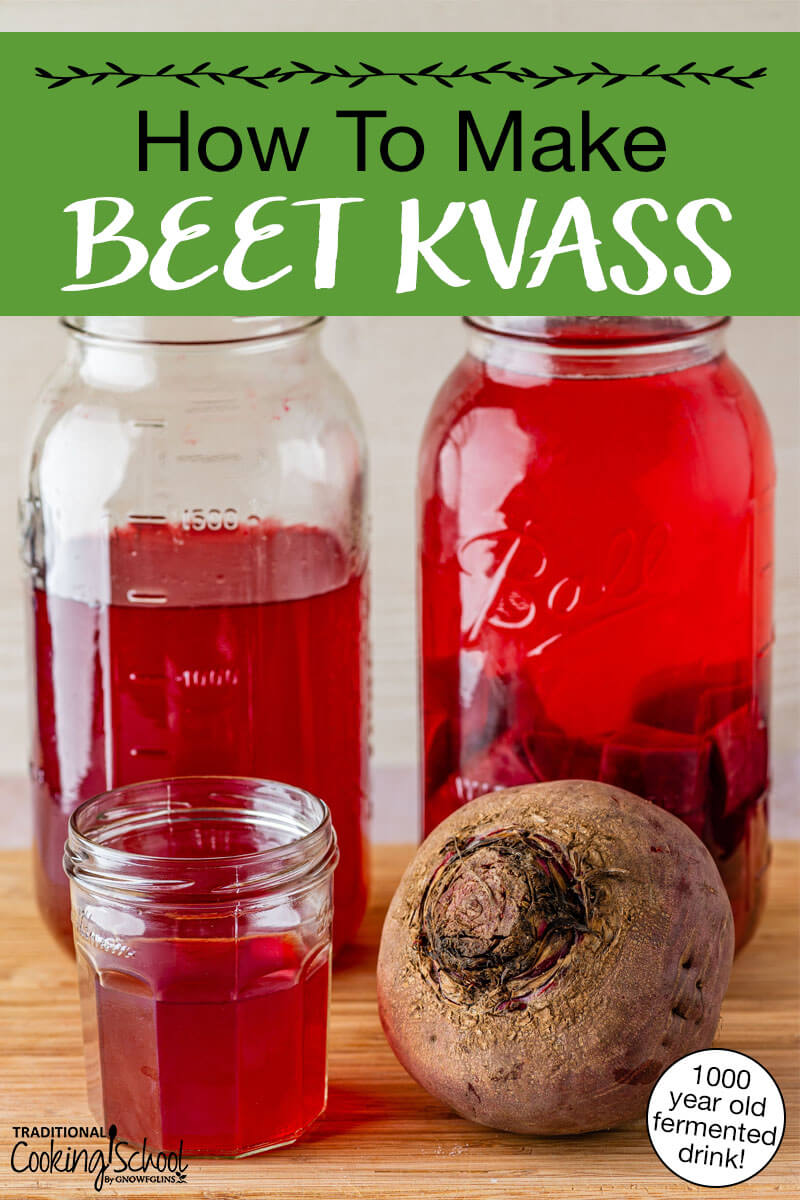
For those of us who cannot use whey, do you happen to know of effective alternatives? Ferment longer? Use a water kefir bug?
When I don’t have whey, I double the salt.
Yes — dairy-free alternatives are listed in this post: https://traditionalcookingschool.com/2011/07/20/free-video-whey-what-it-is-how-to-get-it/
Excellent, thanks!
I have made beet kvass. I think it is an acquired taste, but I drink it knowing it is so good for me. I love your suggestions. I will try your method the next time. Thanks!
What happens to the beets, can’t you eat them?
Kara — You can eat them, but after they make kvass a few times they’re pretty much spent. Kind of like bland fruit that’s finished flavoring water kefir. I give them to the chickens. 🙂
I made beet kvass for the first time a couple of weeks ago. The first morning I drank 4 oz. of it, and a couple of hours later, I felt like I had the flu. I’m assuming that’s the liver detox effect? I drank it twice after that and haven’t since. I really want to do a cleanse of some sort, but that stuff just doesn’t taste good to me AT ALL. Questions: is the flu-like feeling I had shortly after drinking the first shot normal? Does kvass work for a cleanse?
Yes flu l;ike this has happenned to me and the only other person i know who drank it? what isgoing on can anyone help with info onthis? I love the taste by the way .
+ I never get the flu and am preetty sure its not the flu.
To make is intesting you can add some spice. It sound something llike Indian people drink called “KANJI” The only difference is that we add red peppers to taste along with anise seed. It comes out delicious and energizing. It is usually consumed during the month of march and april because that is when black carrots mature but overhear you canfind beets around the year.
As a fellow owner of Nourishing Traditions, I tried making this beet kvass once. It all looked fine and good until the jar exploded within the white antique cabinet that sat inside the back door entry. Red beet juice everywhere – white cabinet, wood floors – not to mention the glass ball jar that exploded into a million pieces. I hope one of these days I’ll still get to try a taste of some beet kvass! 🙂
How long will the kvass keep in the fridge? I’ve been making a jar or 2 each week for awhile now since beets have been available at my Farmer’s Market. My local grocery stores never have beets that look very good any other time of year. (I hope I can drink all the kvass before it goes bad!)
Rhonda
Wardee, this is great info! I have a TON of beets that I just haven’t gotten around to doing anything with yet. I’m planning on lacto-fermenting some of them, but didn’t want to do that with them all. My family is not too thrilled with eating them roasted, but I’m pretty sure they’ll take shots of beet kvass if I tell them it’s healthy. Thanks a bunch!!
Heather, we just boil our cubed up beets with a large slab of butter. It almost tastes like corn that way!
An excellent blood tonic?
I found out yesterday at a physical that my hemoglobin is low-8.2. I think I’ll make a batch of this!
I love my beet kvass and usually make it just adding the sea salt without whey. I make 2 batches, each taking 2-3 days. I put them in a pitcher in the refrigerater to drink after adding a couple tablespoons of probiotic hotsauce made from blended ginger, garlic, peppers and onion. It gives it a nice spicy flavor and adds a tangy snappy effervescence. Later I decant into glass wine or olive bottles to save for consumption a little later. Mine only last a couple months at the most before it is gone … but then I have beets all year long and make it whenever I run out.
Wardee,
I wrote you awhile back about Kombucha Tea! I just wanted to report great success in making my own scoby and subsiquent batchs to the point that I ranout of containers and stored my scobies in their tea in the fridge! Now I am ready to make more, how long should I take to return scobies to room temperature after removing from fridge?
Thank you I love your blog.
Jean
I’ve become a fan of beets…but Beet Kvass is so salty. Its hard for me to drink.
I have found that when it ages the salty taste seems to decrease a little. I have successfully kept mine in the fridge for 1 year. I have not been able to find anything on how long beet kvaas keeps in the fridge but mine tastes delicious.
I love kvass, but I love salty and earthy so that’s really a no-brainer. For the kids I like to take peeled hard boiled eggs and soak them in kvass for a while, it turns them bright pink! The chilluns love them like that. Sauerkraut juice from red cabbage will turn peeled eggs blue, if you’re curious.
When I was on GAPS (I need to get back onto that) I depleted my sauerkraut juice a lot. I topped off my sauerkraut with kvass to keep it from going moldy.
I’ve been making beet kvass a lot lately. I love it!
I make mine without whey, just with sea salt and water.
However, when I’ve tried to make a second batch, even with the same ratio of salt to water, it ends up molding. Any idea why?
My beets are nearly white when my kvass is ready. Weird.
I find the whey from yogurt cheese keeps mine from molding. But I guess I need to ask what kind of water you are using. If it has chlorine or other “purifying” chemicals, it will kill the kvass and it will mold.
I increased the whey and decreased the salt because I found it too salty for me prepared as in Nurturing Traditions. I also add a couple of ounces to completed kvass to smoothies, lemonaide, apple juice, even raw milk and kefir. I’ve also added it to mead that came out too sweet.
I just made beet kvass for the first time a couple of weeks ago. Nourishing Traditions suggests diluting it with water, if desired. It is much more palatable for us when we mix it half and half with filtered water.
@Lindsey. Within several hours of my first drink of beet kvass, I had a horrible headache! I believe it was the cleansing effect. No problems the next day though. Starting out with a few tablespoons might alleviate this for those who haven’t started it yet. 🙂
Instead of the salty version in NT, I learned how to make a great tasting batch from Three Stone Hearth.(Northern CA) It involves using more whey.
First Batch:
2 QT. Mason Jar with tight-fitting lid, not the plastic white ones
1 cup whey
1 tsp. salt
2 to 3 beets
Second Batch:
immediately following the 1st
about 10% of liquid from 1st
all beets from first
water
no more salt or whey needed
I then combine the 2 batches so that I have a healthy, medium tasting one. My kids actually are OK with this. Hope this helps. 🙂
How long do you leave each batch to ferment?
Hi Wardee,
What health benefits do you feel from the kvass?
Ack! I was afraid someone would ask that. For one, I feel more energetic. Second, I am more regular. 🙂
I’ve been making this for my husband who has digestive issues. We think it tastes disgusting, but he drinks it with the hope that it will help heal his gut! My mom grows organic beets, so I have a free source for them and I can’t justify not making it! 🙂
This sounds great! But you really should try some Himalayan pink salt. I get mine from Sustainable Sourcing https://secure.sustainablesourcing.com. The flavor is so much better than regular salt! Thanks for sharing this recipe—I can’t wait to try it!
Deb — I love Himalayan sea salt and that’s what I primarily use for everything — fermenting to cheese to table. Thanks for sharing!
Hi Wardee,
I noticed that after the ingredient list, it says it makes a quart, but you are using a 1/2 gallon jar (is that 2 quarts, Im on the British system!)
I’ve just finished making some and put it into a 1 litre (quart) container, should I move it to a bigger container?
Also, I just took some ‘Sprouted Spelt Raisin Cupcakes’, from your menu lists, out of the oven. They are NICE.
That was the first time I have made anything with sprouted flour. It was interesting in itself as I havent got my grain mill yet (its on its way, yippee!), so here I was trying to grind the grains in all sorts of appliances, like coffee grinders, etc.
Cheers
Fiona
Fiona — I make it in a 1/2 gallon jar, and when I pour off the kvass (leaving behind the beets and the 10% of finished kvass) there is about a quart of it ready to drink. Actually, a little bit more than a quart finished. 🙂 Glad you enjoyed the cupcakes — Sonya created those!
I wish I loved kvass! I made it for my family a couple of years ago, but we never developed a taste for it. My husband’s comment was, “It tastes like dirt.” Maybe I’ll try again and add some spice.
Well, Ive just drank some of the first fermentation.
I love it (I love beetroot anyway, so not a big jump for me)
My daughter (22yrs) looked like I was trying to poison her but I made her drink it anyway. That’ll teach her to complain about being run down…
So, Ive put the second fermentaton on, and, after reading one of the posts above about kanji, I put some whole star anise in and some ground cayenne pepper ( I didnt have plain anise or whole peppers).
I’ll report back on the next stage.
But so far – a vote for Beet Kvass!
Cheers
Fi
I just used this recipe to make my first Kvass. I’m trying it as I write. I love beets, and this tastes like salty beet water, so I’m fine with it. The only thing is, I thought it would be a little bubbly. Might I have done something wrong? My beets were a little old (I think this is why my kvass is lighter in color or maybe the color is due to adding almost 2 qts water?). The whey I used was from making chevre, so it was heated. Also I just covered my jar (vase-I don’t have a 1/2 gal mason) with Glad Press n’ Seal and a fat rubber band.
I just realized I sound like those people who give a recipe a bad review when they changed everything about it, lol. I’m not giving this a bad review, just wondering if I did it right.
Thanks 🙂
Alicia — It is not bubbly. There may be bubbles at the top, though, as a sign of good fermentation. It is fine to cover your jar the way you did. 🙂
How high was the milk heated when making chevre? That’s my only concern — whether or not beneficial organisms were in the whey.
The milk was a bit sour and looked a little separated when I started so I didn’t heat it to the 180 F the recipe said. I think it was between 120 and 130. There were some tiny bubbles around the edge with small white flecks floating in different layers at the top of the jar. And the second batch I started last night looks to have tiny bubbles around the top too and when I turn the jar lots of tiny bubbles rise.
I’m pretty excited about this, thank you for sharing and helping!
Alicia — 120 to 130 is too hot for the cultures, so they likely perished. It doesn’t mean your kvass is bad, it just means that fermentation will take longer because it didn’t have a strong colony of starter organisms from the beginning. I’d guess you need 4 to 5 days instead of 2 to 3. Seeing those bubbles is a good sign! Seems like that ferment wants to take off with or without a starter!
Here’s a video about whey that should help you understand what whey is good to use and what is not: https://traditionalcookingschool.com/2011/07/20/free-video-whey-what-it-is-how-to-get-it/
Thank you for the video link, Wardee. That was helpful to see demonstrated.
I wonder if I mis-guessed(?) my temp, although I’m sure it was above 100.
The second batch I started was much darker than the first. I used a little less water and salt since I think I put too much water in the first time. The flavor was less salty and richer. I really liked it! I’m going to keep trying and use one of the methods you mentioned for collecting the whey.
Thanks again 🙂
Mine is a little carbonated. I let it sit in the fridge for a month or two for it to get that way. Maybe it was longer than 2 months but it takes time. I am on my last bottle of beet kvaas out of my fridge and it’s a little fizzy but not as fizzy as bread kvaas.
Put together our first batch of kvass yesterday. We used beets, Celtic Sea Salt, reverse osmosis water and whey. It now looks like there is mold growing on top. I’m not sure what I’m doing wrong. Help! I don’t want to waste food. We are on very limited budget.
Jim — skim off the mold daily. Underneath should be fine. Let your nose be your guide. Spoiled ferments have an awful disgusting smell.
We do not have flouride in our city water (just found out HURRAY) and we purify it. Do we still need to get non-city water?
Debra — If your water is filtered, it is fine. 🙂
Hi Wardee,
I’m trying Kvass for the first time today. I want to make it not too salty especially since we’ve never tasted it before – and the family will revolt : ) if it is extreme. I’ve read that sometimes NT recipes are a bit salty and was hoping for a reduced salt formula that is still good – and good for us. So I was glad to see your recipe, but I’m just a little confused. NT recipe calls for 1 tablespoon sea salt (pg 610). I see that you say you use less salt, but your recipe (for the first batch) calls for 1 and 1/2 tablespoons. Do you mean teaspoons for your recipe, or am I just not understanding?
I love your site and blogs and newsletters! Thank you so much.
Josephine — I’m sorry to confuse you. I think I thought the NT recipe called for 2 T salt. The amounts I listed above are what I use. If you think that is too much for you, feel free to reduce it to 1 T or 1/2 T. I’ll go correct my note above — obviously I am NOT using less! 🙂
Hey! I’m making kvass for the first time! *fingers crossed* I’ve never made anything with beets before and when I cut into them they were yellow! I was quite surprised! I guess I purchased golden beets. Ha ha! Is this still going to be good?
Lisa — They’ll work! Not the same color result, but that’s okay. 🙂
Hi, first of all, I absolutely love your website! Out of all of the ones I’ve read, this is the one that has really encouraged me to start trying fermentation and bean sprouting. As a recovering germaphobe, I am always a little paranoid about shelf life. I would love to know how long will the juice be good for when refrigerated. Would be forever grateful if anyone could let me know, Thanks!
Julie
Julia — This kvass last many weeks in the fridge. 🙂
Recipe says makes 1 quart. Also says to fill a half gallon jar to within an inch of the top. ?????
Angela — The yield is 1 quart, but you’ll need a bigger jar to fit both the liquid and the cut up beets.
To the commenters mentioning that their beet kvass tasted disgusting or like dirt — throw it out and start over. Beet kvass is supposed to taste delicious! I don’t even like beets at all but beet kvass at room temperature is absolutely delicious. My preschooler and I can polish off a whole quart in one sitting!
My tried and true recipe: very fresh organic beets, well washed and peeled, cut into large chunks — full a 1-qt Mason jar between 1/3-1/2 full with the chunks. Add 1 tbsp fine-ground unrefined sea salt (I am using RealSalt currently), plus 1/4 cup whey (raw!! We use raw whey from a farmer who has it as a byproduct of making cheese but whey from dripping high-quality organic commercial yogurt will work fine), and 2-3 peeled garlic cloves. Top off with filtered water, put on the lid, and leave it at room temp for 5 days. The longer fermenting and the garlic make all the difference, plus using plenty of beet pieces in each jar. If there is any brownish scum on the surface when you’re done fermenting just dip in a metal spoon and it will stick to the spoon so you can remove it easily. Strain out the kvass into another quart jar and top off this jar with filtered water. I never reuse the beets bc it’s too weak the second time. If it is brownish rather than a dense lovely purple, or if it tastes like dirt toss it out and try again! I have had this happen more than a few times. It seems to be a freak accident possibly related to the freshness (or lack thereof?) of the beets. And it’s worth saying again that it is SO much better when at room temperature. I find it loses it’s appeal when cold.
Wardee-
I’ve been making beet kvass, but it is sooo salty. I see your recipe says that you use less than the Nourishing Traditions recipe. You use 1.5 Tablespoons. But my NT cookbook uses 1 T. of salt, so you use MORE ….??
Is it correct that you use 1.5 Tablespoons?
Thanks. I want to be able to drink my kvass, but also want it to be safe.
I saw online somewhere a recipe where they use 2 t. (per 2 qt.) … I’d try that if I knew it is safe.
Hi, Donna.
I do as little as 1/2 tablespoon since writing this recipe. It turns out quite good and not so salty. 🙂
I’ve made several batches of beet kvass with good results. Thank you for all the good information on your blog…it has really helped. But I’d like to know, technically speaking, could the beet kvass be fermented in the fridge from start to finish? It would take longer, I know, but it would beat the kahm yeast issue. It is super-hot in the summer-time (which lasts about 6 months) in far-west Texas. I use plain, big glass jars. I understand even with Pickl-It jars the yeast thing can happen. Thanks so much for your answer.
Madeleine,
You could certainly try a cool-temp ferment for the kvass, though I’m thinking it won’t work as well. The lactobacilli that do the work are active at room temperature and significantly slowed in the fridge.
After making two batches, can you save 10% of the liquid as starter for new beet chunks, or is it better to start over completely?
Melissa, you can definitely do that. 🙂
I am on my fifth 1/2 gal batch of kvass and loving it. The kids not so much, so I mix in a 16 oz pitcher 1/3 kvass, 1/3 kombucha and 1/3 POM pomegranate juice. We have 4oz of this in am and pm before meals. No more complaints from the kiddos.
I make it in 64oz Ball mason jar, with 2tsp sea salt and 1/4 c whey from my milk kefir. I first tried it with only salt and it was too salt, I prefer the salt/whey combo. In my current batch I’ve added ginger, haven’t tried yet. I go for 3 batches from the beets, the last batch filling only 3/4 full, as it comes out weaker, beets totally spent. Storing it in the cabinet above the fridge keeps it happy, it’s the warmest spot in the kitchen.
I find it provides me with more energy in the morning, replacing my coffee habit, which was not enriching my blood like kvass does. I am looking forward to trying different kvass recipes, maybe adding carrots, anise seeds, or lemon, etc.
Kvass sells for $5 for a 12oz bottle at the local health food store. I make about 48 oz for less than $2. It feels so empowering, for lack of better word, to make something so simple that is intensely healthy. It’s like finding a treasure, a blessing actually. I appreciate all the posts regarding kvass, nice to know I am not alone.
Hi. I have a question and a comment. First of all, I just got home from the farmers’ market and have a beautiful bunch of golden beets which I could not pass up because I love golden beet tops. I’m wondering if I can make beet kvass with golden beets? I’ve searched online and have not seen anything that references golden beets with regard to kvass. Nor do any pics of kvass appear to have been made with golden beets – the pics are all that deep, vibrant red of red beets.
Secondly, I have made beet kvass – with red beets – a couple ways. My favorite so far is to leave out the whey, use a lesser amount of salt than most recipes call for, add some cabbage, a couple cloves of garlic and a bay leaf or two. I use a gallon jar and ferment for 30 or even 40 days. The longer it ferments, the better it gets. I seal my jar but I open it every 5-7 days to release whatever it is that can cause the jars to blow up.
So I have read a lot of recipes for kvass and I am still not clear on what is best – covered loosely with a towel or the like, or sealed air-tight? Or covered loosely at first and then tightly in the fridge to get some fizz going?
I cover with a coffee filter and then strain and bottle with a tight cap in the fridge. Over time it will build up a bit of fizz. Mine is not super fizzy like root beer or anything. I have made other kvas’ also with carrots, ginger and orange peel. That tastes pretty good and did get more fizzy than the beets. I also made mixed greens kvas and that one definitely is an acquired taste type of thing.
I used Zero Water filtered water and the kvass went bad quickly. City water, just fine.
I made this recipe and turned out great! I added garlic, ginger, and lots of different seeds you suggested in optional extras. Will try to keep making, my kids drink it faster than i can keep up and we eat the beetroot slices as condiment with food. Love it!
I’ve made this a couple of times now and not sure if its 100% right.
It’s definitely salty but not sour, so I guess that’s why I question it.
I didn’t feel any detox effects at all.
I left mine for over 7 days as it wasn’t quite right, but hey I’m not even sure about that either lol. Is there a max time you can leave it ferment before it’s not safe to consume?
I would like to know:
-how to keep the beets from rising?
-is there a ratio between beets and water in the one jar? (I did 3 beets, they were on the larger side, however I used about 5-6 jars (1-1.8L) not quite 1/2 gallon you used.
Thanks Maroula
Hi Maroula,
It all depends on the climate of your home, live cultures you are using and other factors that may contribute to it not getting the sourness. If your jar is full and you are only fermenting 2-3 days you don’t really need weights but you can buy fermenting weights from Cultures for Health, here is a resource page with links and some have coupon codes, click on the Lacto-Fermentation: https://traditionalcookingschool.com/tools/?swcfpc=1
You will want to scale up or down depending the size jar you are using, use Wardee’s ratio of approximately 3 medium beets about 3″ to 4″ diameter in a half gallon jar. This will fill approximately 1/4-1/2 of the jar. Using the right ratio of water, salt and whey is important.
We can help you further with our traditinal cooking school program. Would you like more info about our program?
Here is a link for more info:
https://lp.traditionalcookingschool.com/lp/bible-based-cooking-program-direct/
I’m happy to answer questions about the program so you can get plugged in and get the help you need!
~Peggy, TCS Customer Success Team
Thanks for the tips Peggy.
Unfortunately shipping to get to Australia would be too much.
Yes these courses are something on my to do list.
Thank you again.